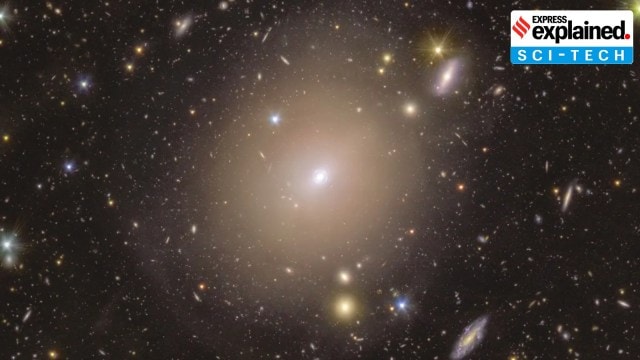Scientists discover ‘Einstein ring’ around nearby galaxy: What it is, its significance (original) (raw)
 The ring of light surrounding the center of the galaxy NGC 6505, captured by ESA’s Euclid telescope, is an example of an Einstein ring. (Photo: ESA)
The ring of light surrounding the center of the galaxy NGC 6505, captured by ESA’s Euclid telescope, is an example of an Einstein ring. (Photo: ESA)
The European Space Agency’s (ESA) Euclid space telescope has discovered a rare ring of light, known as an Einstein ring, around a galaxy nearly 590 million light-years away from Earth.
Photos, which were taken by Euclid in September 2023 but released on Monday, of the Einstein ring show a bright ball of light in the centre with a bright, cloudy ring around it. The ring was discovered around NGC 6505, a galaxy that was first found in the 19th Century.

Stephen Serjeant, an astronomer at the Open University, told The Guardian, “This is a beautiful, extraordinary, thrilling and lucky find in our first data.”
What is an Einstein ring?
An Einstein ring is a ring of light around a form of dark matter, galaxy or cluster of galaxies. It is essentially an example of gravitational lensing. Gravitational lensing is a phenomenon which occurs when a massive celestial body — such as a galaxy or cluster of galaxies — creates a gravitational field which distorts and amplifies the light from distant galaxies that are behind it but in the same line of sight, according to a report on the website of National Aeronautics and Space Administration (NASA). The body causing the light to curve is called a gravitational lens.
In the case of the recently discovered Einstein ring, NGC 6505 was the gravitational lens. The nearer galaxy distorted and amplified the light coming from a distant unnamed galaxy, located 4.42 billion light-years away. A light-year is the distance light travels in one year, which is 9.46 trillion kilometres.
Xiaosheng Huang, a physics and astronomy professor at the University of San Francisco, told NPR that gravitational lensing can result “in several types of image configurations”, including an Einstein ring, which is the most striking one.
Einstein rings are named after mathematician and physicist Albert Einstein, whose general theory of relativity predicted that light could bend and brighten around objects across the cosmos. The first Einstein ring was discovered in 1987, and since then, several more have been discovered. However, it remains unclear how many such rings exist. Notably, they are extremely rare — less than 1% of galaxies have an Einstein ring, according to experts.
Story continues below this ad
Einstein rings are not visible to the naked eye, and can be observed only through space telescopes such as Euclid.
Why do scientists study Einstein rings?
These rings help scientists investigate dark matter, which has never been detected but is believed to make up 85% of the total matter in the universe.
Conor O’Riordan, a postdoctoral scholar at the Max Planck Institute for Astrophysics (Germany), told CNN, “This dark matter does not interact with light, but it does have a gravitational effect… Gravitational lensing therefore is sensitive to the presence of this dark matter, allowing us to indirectly detect it.”
Moreover, Einstein rings enable scientists to learn about distant galaxies, which otherwise might not be visible. They can also provide information about the expansion of the universe as the space between the Earth and other galaxies — both in the foreground and the background — is stretching, according to NASA.